In a major development on the international stage, former President Donald J. Trump announced early Saturday that U.S.-facilitated negotiations have led to a “full and immediate ceasefire” between India and Pakistan, effectively halting one of the most serious military escalations in South Asia in recent years. The ceasefire, finalized through intense backchannel diplomacy led by Trump’s team, represents a significant foreign policy victory and a strong example of how American influence—when used effectively—can preserve peace without military entanglement.
This announcement follows a dramatic escalation between the two nuclear-armed nations, which began after a deadly militant attack in Indian-controlled Kashmir earlier this month. India blamed the assault on Pakistani-based terrorist groups, specifically Jaish-e-Mohammed, a group previously linked to similar attacks. In response, the Indian Air Force launched pre-emptive missile strikes on alleged terrorist training camps and Pakistani military installations in the Khyber Pakhtunkhwa province, targeting what India said were “imminent threats.”
Pakistan swiftly retaliated with a coordinated response involving both drone strikes and long-range missile fire, claiming to have struck Indian radar sites and logistics bases. The hostilities marked one of the most dangerous exchanges between the two countries since the 2019 Pulwama-Balakot crisis, reigniting fears that the longstanding Kashmir conflict could once again spiral into a broader regional war.
Both India and Pakistan possess an estimated 160–170 nuclear warheads each, according to the Federation of American Scientists. With relations already strained by decades of military tension and three full-scale wars since 1947, the international community was quick to react. The United Nations, European Union, and regional powers like China and Russia expressed grave concern over the situation.
In particular, U.S. intelligence assessments had warned of the “high probability of further escalation” if the conflict was not promptly addressed. The potential for miscalculation between two nuclear powers with large standing armies raised alarms not just in Washington, but across world capitals.
Recognizing the risk of global instability, President Trump’s diplomatic team moved rapidly to open lines of communication with both New Delhi and Islamabad. Secretary of State Marco Rubio, in coordination with Vice President JD Vance and National Security Advisor Ric Grenell, spearheaded behind-the-scenes negotiations that included phone calls, third-party envoys, and real-time intelligence sharing.
President Trump, who posted the news to his Truth Social account, hailed the ceasefire as “an incredible outcome resulting from strong diplomacy, mutual respect, and the leadership of nations who want peace, not war.” He praised both Prime Minister Narendra Modi of India and Prime Minister Shehbaz Sharif of Pakistan for their “wise and responsible” decision to halt military operations.
Pakistan’s Deputy Prime Minister Ishaq Dar confirmed the ceasefire on the BBC’s “HardTalk” program, stating that “Pakistan has never shied away from diplomacy, but we reserve the right to defend our sovereignty. We welcome the ceasefire and appreciate President Trump’s role in helping reach it.”
From the Indian side, Foreign Secretary Vikram Misri told NDTV that India had agreed to the ceasefire after clear guarantees were made regarding the halting of cross-border insurgency support. Misri said, “We have made our position clear: we will not tolerate terrorism. However, we are willing to pursue peace if meaningful commitments are upheld.”
Both countries agreed to a comprehensive cessation of military activity by land, air, and sea—a crucial move to de-escalate tensions not just in Kashmir, but along the Line of Control and international border areas.
In a joint press briefing, Secretary Rubio emphasized that “peace through strength and communication is the cornerstone of President Trump’s foreign policy.” He credited the calm yet firm approach of U.S. negotiators for bringing both sides to the table.
Vice President JD Vance reiterated that the U.S. was not taking sides in the dispute but acted out of concern for global stability and economic impact. “We are not here to police the world, but we do recognize the importance of preserving peace between nations that could destabilize entire regions,” Vance said on Fox News.
This ceasefire is being hailed by many foreign policy experts as a reaffirmation of American diplomatic strength, achieved without a single soldier deployed. It echoes Trump’s earlier successes in brokering peace deals such as the Abraham Accords in the Middle East and the historic normalization agreements between Israel and Arab states.
Dr. Reza Mahmood, a geopolitical analyst with the Hudson Institute, noted that “Trump’s direct, no-nonsense approach to foreign affairs—combined with clear messaging and leverage—continues to yield results where others have failed.”
Conservative outlets have praised the Trump administration for demonstrating once again that American influence, when used decisively, can bring peace without permanent entanglements. The administration’s critics often paint its foreign policy as unorthodox, but results like this one speak volumes about the effectiveness of tough diplomacy backed by strength.
This ceasefire may also have ripple effects on international trade, energy stability, and U.S. strategic interests in the Indo-Pacific, particularly as China continues to expand its regional influence. De-escalating a conflict between two major players like India and Pakistan contributes directly to global economic and political stability.
While tensions in South Asia are far from permanently resolved, the successful implementation of this ceasefire is a testament to the power of U.S.-led diplomacy and a firm but fair foreign policy doctrine. As the situation continues to evolve, further negotiations are expected to address deeper issues, including terrorism, border disputes, and regional cooperation.
This development serves as a stark reminder that leadership matters—and when applied with wisdom and clarity, it can prevent wars and save lives. The Trump administration’s handling of this crisis stands as yet another example of how strength, clarity, and engagement can defuse even the most dangerous global flashpoints.



